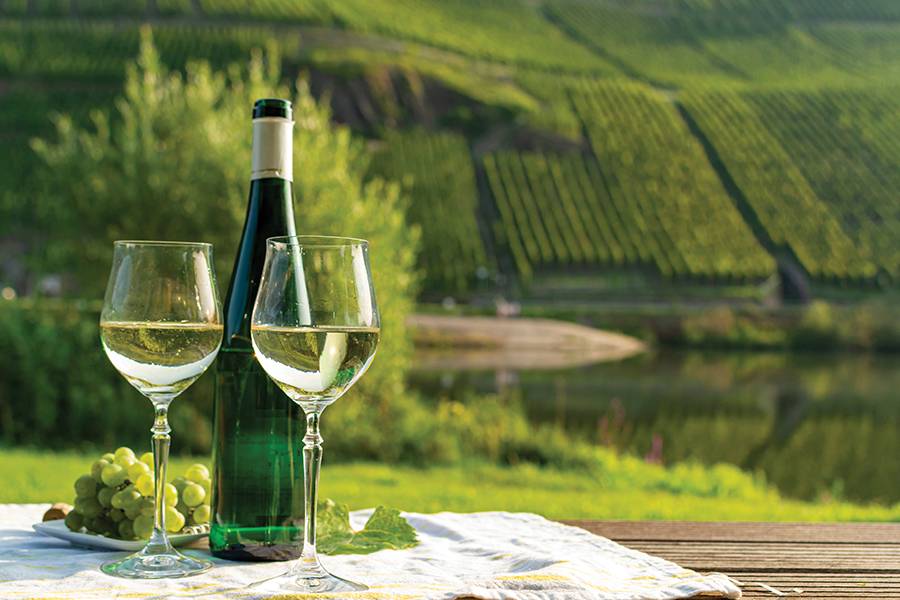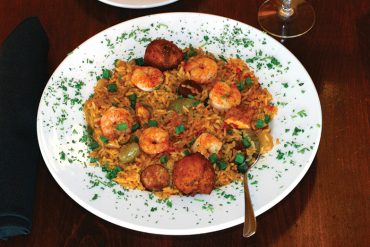Attention wine lovers. Not all Rieslings are sweet. A look at why German wine is definitely worth the time.
By Matthew DeBord
HQ 113 | SPRING 2021
I consider myself a seasoned wine expert who can converse rather confidently about a wide range of bottlings, regions, varietals and even the correct choice of glassware. But I have a tough time keeping German wines straight, and I’m not alone. One can know just about everything when it comes to French Bordeaux or Burgundy, California Cabernet and Chardonnay, Australian dessert wines, Port, Italian Chianti or Spanish Rioja, yet still be a veritable ignoramus when it comes to the vino of the Germans.
That’s because the best German wines are made from Riesling, a grape that was wildly popular in Europe and the U.S. in the 19th and first half of the 20th century, but that developed a bad reputation for being simple and sweet and therefore not as worthy of connoisseurship as Pinot Noir or Sauvignon Blanc.
Riesling is a hardy, easy-to-grow grape; and for decades outside of Germany it was raised in unruly vineyards that produced bumper crops of early-ripening fruit that was made into gallons of wine whose sweetness was welcome, not spurned.
Tastes change, and sometimes they change quickly. And so Riesling plummeted in popularity as the red wines of California boomed in the 1980s.
Nowadays, the reason to drink German wines and to focus on Riesling is that the wines are so misunderstood that values abound. For what you pay for a mediocre California red, you could enjoy a superb German Riesling. And the enjoyment comes with a lower next-day penalty because Rieslings are often lower in alcohol content than most of the world’s other big-name wines. That means an extra glass without fear of a fuzzy head.
Germany has a cool climate, relative to the likes of Spain and southern France and Italy, so the country’s Rieslings historically went through a shorter fermentation that left some residual sugar in the wines, hence the lower alcohol. The sweetness, delicate floral aromas and flavors of citrus, stone fruit, pears and apples are often offset by bracing acidity. That means German Riesling makes an excellent companion to food — and not just seafood and salads. The Germans have been washing down their rich cuisine with Riesling for centuries. To top it all off, if you dislike oaky Chardonnays, Rieslings are the antidote: they don’t go through barrel-aging.
To make matters simple, rather than seek out specific winemakers, when it comes to Riesling
I recommend that you zero in on regions. Two that you’ll find in wine stores and online are Mosel and Pfalz, with the former showing a classic sweeter style and the latter offering a dry approach. The majority of wines you’ll explore are Kabinetts, which are the least sweet. If you like what you taste, you could graduate to the richer, sweeter wines, Spätleses and Ausleses, and even dive into the really heavy, complicated stuff, with equally complex names like Beerenausleses and Trokenbeerenausleses.
Pretty soon, you will discern that Kabinett Mosel Rieslings make lovely “cocktail” wines that get along famously with cheeses and cold cuts. But they can also carry you through an entire meal, from appetizer to dessert. And Riesling is considered by many wine enthusiasts to be the only alcoholic beverage that can be paired with Asian cuisines. (I agree, but also think that Champagne is great with Chinese food!)
My greatest Riesling pairings, however, usually involve freshwater fish such as trout or bass. German Riesling actually adds to the delicate texture and flavor of trout, and you can’t go wrong with a grilled whole fish and a nice Pfalz, with some roasted parsnips on the side and a plate of heavy, pungent cheeses at the end for the Riesling’s acidity to cut through.
Mind you, there are German red wines including Pinot Noir. They’re fine; but for most wine drinkers, they’re on the thin side, and they need a menu that features creamy sauces, roasted pork, breaded entrees that have been through the fryer — wonderful food, but not exactly what most modern gourmets are dining on or serving to their friends, much less seeking out at restaurants.
Speaking of restaurants, the next time you find yourself staring at a wine list and blanching at the prices, turn to the German page and choose a Riesling. Chances are better than good that it will be an overlooked gem that wows everybody with how well it matches up with lunch or dinner. This is why German wine is worth the time: the bang for the buck is, frankly, incredible. And while the labels and names might at first seem incomprehensible, if you keep it simple, you almost can’t go wrong.





